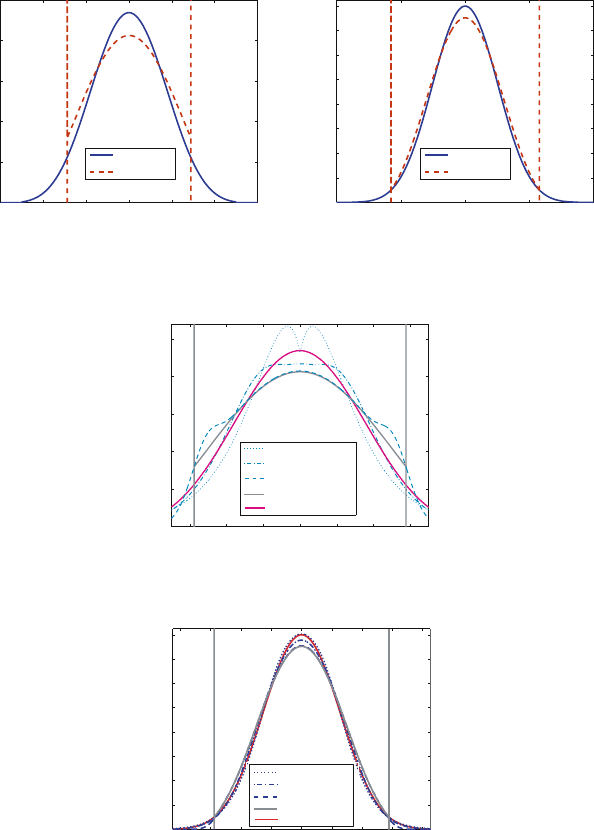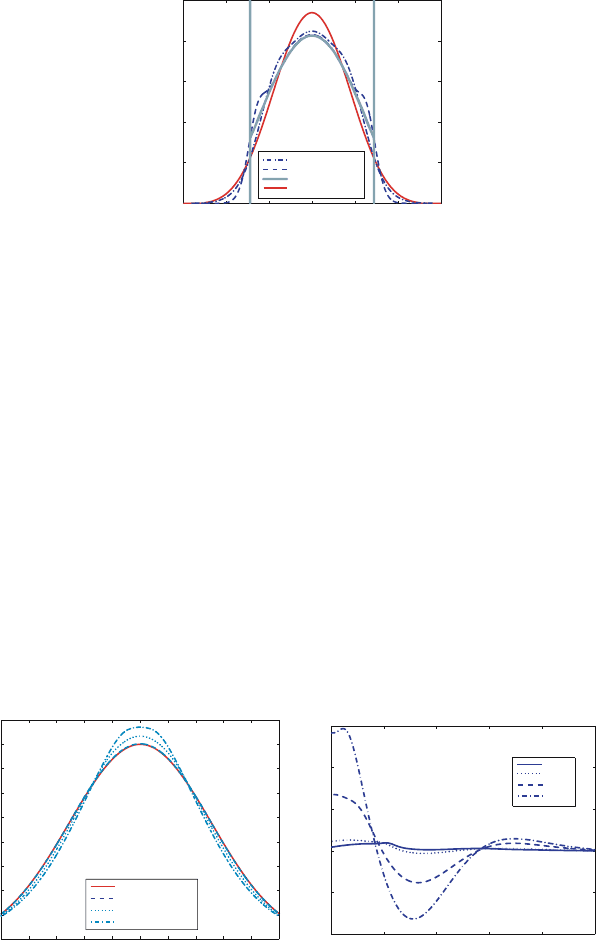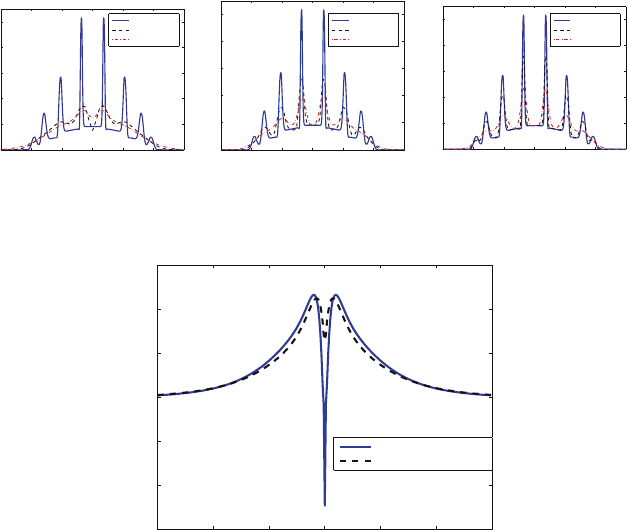Graziani F. (editor) Computational Methods in Transport
Подождите немного. Документ загружается.


460 R. McClarren et al.
This flux can be transformed to the standard form of the Riemann solver
community by adding and subtracting
λ
k
>0
λ
k
l
k
· (u
r
) r
k
to (13)
F(0,t)=
λ
k
>0
λ
k
l
k
· u
l
r
k
+
λ
k
<0
λ
k
l
k
· u
r
r
k
+
λ
k
>0
λ
k
l
k
· u
r
r
k
−
λ
k
>0
λ
k
l
k
· u
r
r
k
. (14)
Now looking at each term
λ
k
>0
λ
k
l
k
· u
l
r
k
−
λ
k
>0
λ
k
l
k
· u
i
r
k
=
λ
k
>0
λ
k
l
k
· [u
l
− u
i
] r
k
= −
λ
k
>0
λ
k
l
k
· [u
i
− u
l
] r
k
= −
λ
k
>0
λ
k
l
k
· [∆u] r
k
,
(15)
where ∆u = u
r
− u
l
. The other terms
λ
k
<0
λ
k
l
k
· u
r
r
k
+
λ
k
>0
λ
k
l
k
· u
r
r
k
=
λ
k
λ
k
l
k
· u
r
r
k
=
λ
k
r
k
λ
k
l
k
· u
r
= Ru
r
.
(16)
Combining these to get
F(0,t)=Ru
r
−
λ
k
>0
λ
k
l
k
· ∆ur
k
. (17)
Similarly, if we add and subtract
λ
k
<0
λ
k
l
k
· u
l
r
k
to (13) the result is
F(0,t)=Ru
l
+
λ
k
<0
λ
k
l
k
· ∆ur
k
. (18)
Averaging (17) and (18) gives
F(0,t)=
1
2
R(u
r
+ u
l
) −
1
2
λ
k
|λ
k
|l
k
· ∆ur
k
. (19)
The solution to the Riemann problem – the flux between two cells – is writ-
ten in (19) as a centered-difference scheme plus the minimum amount of
dissipation to stabilize the scheme. However, the form in (13) shows us the
real power of using this approach. In this expression it is easily seen that
information is propagated upwind only, i.e. u
l
only contributes for positive
eigenvalues and u
r
only for negative eigenvalues. We could immediately use
this result in (2) by relabelling the l subscripts i − 1andther subscripts i.

Implicit Riemann Solvers for the P
n
Equations 461
4 High Resolution Flux from Linear Reconstruction
The preceding method for calculating the flux between two cells is only first
order in space when used on a cell-averaged quantities in solving a differential
equation. To create a scheme with greater spatial resolution we would like
to perform an interpolation of cell averaged quantities to reconstruct a more
precise value of ψ at the interface. A simple linear interpolation on each side
of the cell to get ψ
i±1/2
would be the obvious choice. However, Godunov’s
Theorem [Lev1992] tells us that linear reconstruction would only be first
order in space if we prevent artificial oscillations (as we would be wont to
do). Ergo, we will use a nonlinear slope calculation which prevents artificial
maxima and minima creation (i.e. spurious oscillations).
The method first suggested by Van Leer [Lev1992] for fluid dynamics
applications and championed by Brunner [Bru2000] for particle transport is
the harmonic mean limiter. In this approach the slope at either side of an
interface is calculated using linear interpolation
m
−
=
u
i
− u
i−1
∆x
(20)
m
+
=
u
i+1
− u
i
∆x
, (21)
where u
i
is an element in the vector u
i
. Then we compute the harmonic mean
of the neighboring slopes
m
i
=
2m
+
m
−
m
+
+ m
−
=
|m
+
|m
−
+ |m
−
|m
+
|m
+
| + |m
−
|
(22)
If the sign of m
−
does not equal the sign of m
+
thenweneedtosetm
i
=0
because cell i is an extremum and interpolation could create artificial extrema
at its interfaces. Fortunately, the second form of the harmonic mean in (22)
does this automatically and does not compel the use of conditional statements
to check if each cell is an extreme point. In the case when both m
+
and m
−
are of the same sign, then we set
u
i±1/2
= u
i
±
∆x
2
m
i
. (23)
Withal, this method of reconstructing u
i±1/2
ensures that u
i±1/2
is always
between u
i−1
and u
i+1
.
This method has two new wrinkles compared to the first-order scheme. In
that low-resolution scheme the average value or u
i
was used as the value at the
interfaces u
i±1/2
. The high-resolution method interpolates a linear function
to reconstruct the value of u
i±1/2
. This reconstruction does not take place at
extreme points in the values of u
i
; at these cells the method is still first-order.
The other dissimilar facet of the high-resolution method is its nonlinearity, a
difference that will become significant when treating the time integration.

462 R. McClarren et al.
The slope reconstruction method can be substituted into (19)
F(0,t)=
1
2
R
u
i
−
∆x
2
m
i
+ u
i−1
+
∆x
2
m
i−1
−
1
2
λ
k
|λ
k
|l
k
·
u
i
−
∆x
2
m
i
− u
i−1
−
∆x
2
m
i−1
r
k
. (24)
5 Time Integration
Now we have two expressions for the F’s in (2), for both high-resolution and
first-order spatial schemes. There remains the time derivative component of
(2) to handle. We will do this using implicit time integration methods in order
to not be confined by the Courant-Friedrichs-Lewy limit (c∆t/∆x < 1). The
backward (or implicit) Euler method is a first order method given by setting
∂ψ
i
∂t
≈
ψ
i
(t + ∆t) −ψ
i
(t)
∆t
≡
ψ
i
n+1
− ψ
i
n
∆t
, (25)
and presuming all other instances of time-dependent quantities to be known
at time t + ∆t or time-step n + 1. This turns (2) into
1
c
ψ
ψ
n+1
i
− ψ
n
i
∆t
+
1
∆x
F
n+1
i+1/2
− F
n+1
i+1/2
= −Sψψ
n+1
i
+ Q
n+1
i
, (26)
Isolating the quantities at n +1
ψ
ψ
n+1
i
+
c∆t
∆x
F
n+1
i+1/2
− F
n+1
i+1/2
+ c∆tS
ψ
ψ
n+1
i
− c∆tQ
n+1
i
= ψψ
n
i
, (27)
which we write as
f(ψ
n+1
)=ψψ
n
. (28)
The problem given by (28) is a linear system in the case of the first-order
spatial scheme, and nonlinear in the high-resolution case. For the first-order
method, solving (28) involves solving a linear system of (N +1)I equations.
The nonlinear system for the high-resolution scheme has the same number of
equations.
A second-order time integration method, BDF2, was implemented as well.
This method has
∂u
∂t
≈
1
2
u
n−1
− u
n
∆x
+
3
2
u
n+1
− u
n
∆x
, (29)
and the other terms of the equation evaluated at time n + 1. This method
requires that the solution from the two previous time-steps be stored, a re-
quirement that could be problematic for large problems.

Implicit Riemann Solvers for the P
n
Equations 463
6 Implementation
This method for solving the P
n
equations was implemented in a C
++
code
named Implicit Riemann Object-Oriented Solver for the Transport of En-
ergetic Radiation (Implicit ROOSTER). This code uses the Trilinos solver
library, freely available from Sandia National Laboratory. For the solution
of the linear systems that arise in the first-order spatial scheme, a restarted
GMRES solver is utilized (available in the AztecOO package of Trilinos).
The slope reconstruction method, the nonlinear system of equations is
treated using an inexact Newton method. The Newton iterations are defined
by
J
j
x
j+1
= J
j
x
j
− (f (x
j
) − x
0
) , (30)
where the subscripts denote the j
th
approximation to the solution of f(x)=
x
0
and J is the Jacobian of f. This Jacobian is computed using a finite
difference method – meaning that we need not specify it explicitly. Further-
more, we have noticed that an effectual preconditioner is the matrix from
the first-order linear system. This is a reasonable preconditioner because the
high-resolution method is basically the first-order method with a small cor-
rection term. Without this preconditioner the computational cost of even
a small problem was significant; with it the computation time is not much
worse than the time for the first-order method.
7 Results
To test the method we look at a Green’s function problem involving an
isotropic pulse of particles being emitted from a plane source in a 1D in-
finite medium at time t = 0. The medium is purely scattering with Σ
s
=1
and c = 1. There is an analytic transport solution to this problem due
to Ganapol [Gan1986]. An analytic P
1
solution also exists for this prob-
lem [Bru2000]. The P
1
solution is characterized by a delta function of uncol-
lided particles travelling at speed ±
"
1/3. In Fig. 1 these exact solutions are
shown.
In Fig. 2 the numerical solutions 5 seconds after the pulse demonstrate a
smoothing of the spikes in the analytic P
1
solution. In this figure CFL =
∆x
∆t
and CFL > 1 would be unstable for an explicit time integration method.
Even time steps that allow particle to travel across fifty spatial cells in one
time unit show excellent agreement with the analytic P
1
solution. It is clear
that the solutions are converging to the P
1
solution, as would be expected
for a method solving that P
1
equations in discretized form. Figure 3 shows
an interesting coincidence, namely that lower time fidelity (i.e. longer time
steps) yields a solution nearer the transport solution. This is due to the fact
that implicit methods move particles at different speeds than the continu-
ous time equations allow. In this problem, the P
1
speeds are not the correct

464 R. McClarren et al.
−6 −4 −2 0 2 4 6
x
φ
Transport
Analytic P1
−10 −5 0 5 10
φ
x
0
0.02
0.04
0.06
0.08
0.1
0.12
0.14
0.16
0
0.05
0.1
0.15
0.2
0.25
Transport
Analytic P1
Fig. 1. The analytic transport and P
1
solutions to the test problem at T =5and
T = 10 after the pulse
φ
−3 −2 −1 3012
x
dt = 2.5 CFL = 1250
dt = 1, CFL = 500
Transport
Analytic P1
dt = 0.1, CFL = 50
0
0.05
0.1
0.15
0.2
0.25
Fig. 2. The high resolution P
1
solutions between x = −3.5 and 3.5atT =5
−8 −6 −4 −2 80246
x
φ
Transport
dt = 2, CFL = 1000
dt = 1, CFL = 500
dt = 0 1, CFL= 50
Analytic P1
0
0.02
0.04
0.06
0.08
0.1
0.12
0.14
0.16
Fig. 3. The high resolution P
1
solutions at T = 10. The analytic P
1
solution and
the dt = 0.1 solution are coincident in the middle region
speeds for the transport solution. Consequently, by advecting particles at
the wrong P
1
speeds the numerical results happen to be closer to the trans-
port solution than the P
1
solution. However, more importantly the numerical
scheme converged in time captures the analytic P
1
solution. To test the time

Implicit Riemann Solvers for the P
n
Equations 465
−6 −4 −2 0 2 4 6
x
φ
Transport
dt = 0 1, CFL = 200
dt = 0 5, CFL = 1000
Analytic P1
0
0.05
0.1
0.15
0.2
0.25
Fig. 4. The high resolution P
1
solutions at T = 10 with small spatial cells, dx =
0.0005 and large CFL numbers
discretization, the spatial cells were shrunk to dx= 5 × 10
−4
. In Fig. 4 the
time integration error should dominate and the results show that it is still
possible to get reasonable solutions with CFL numbers as high as 10
4
.
At T = 10 after the pulse of particles the numerical P
5
solution converged
in time is sufficient to capture the transport solution. This is demonstrated
in Fig. 5 where the φ
transport
− φ
P
5
≈10
−4
for dt= 10
−1
.
The high resolution and first order spatial scheme was compared on a se-
ries of tests using the P
7
equations. The P
7
solutions have a series of “spikes”
representing the particles travelling at speeds characteristic of the P
7
equa-
tions – much like the delta functions of the P
1
equations. In the series of
plots in Fig. 6, the high resolution method captures these features more ac-
curately for coarse and fine grids. This is advantageous insofar as the high
resolution method does not do worse than the first-order scheme even on
these coarse grids. Finally, results from second-order time integration were
−5 −4 −3 −2 −1 0 1 2 3 4 5
0
0.02
0.04
0.06
0.08
0.1
0.12
0.14
0.16
0.18
x
φ
Transport
dt = 0.1, CFL = 50
dt = 1, CFL = 500
dt = 2, CFL = 1000
−10−8−6−4−20
−0.01
−0.005
0
0.005
0.01
0.015
x
φ
transport
−φ
P5
dt = 0.1
dt = 1
dt = 2
dt = 02
Fig. 5. The P
5
solution and the difference between the transport flux and computed
flux at T =10

466 R. McClarren et al.
P7 at T=1, CFL = 0.25, N
x
= 50
1 0 5 0 5 1 510
P7 at T=1, CFL = 0.25, N
x
= 150
φ
1 5 1 0 5 0 0 5 1 1 5
P7 atT=1, CFL = 0.25, N
x
= 300
HR, N
x
= 600
High Res
1
st
order
HR, N
x
= 600
High Res
1
st
order
HR, N
x
= 600
High Res
1
st
order
0
0 5
1
1 5
2
2 5
φ
0
0 5
1
1 5
2
2 5
φ
0
0 5
1
1 5
2
2 5
1 51 5 1 0 5 0 0 5 1 1 5
xxx
Fig. 6. Comparison of high resolution and first-order solutions to the P
7
equations
with different numbers of spatial grid points
−1.5 −1 0 1−0.5 0.5 1.5
x
φ
BDF2, dt = 0.5
Backward Euler, dt = 0.5
−1.5
−1
−0.5
0
0.5
1
1.5
Fig. 7. The BDF2, high resolution P
7
solution at T = 1 has a negative scalar flux
disheartening. Figure 7 shows the BDF2 solution compared with the back-
ward Euler solution. The negative flux is not desirable. Also, it is worth
noting that in the previous figures the backward Euler method performed
well for large time steps. Moreover, other computations performed with the
BDF2 method demonstrated oscillations near extreme points in the solution.
8 Conclusion
We have presented an implicit Riemann solver for the P
n
equations. The
implicit Riemann solver gives good agreement with the transport solution
in regimes where the P
n
approximation is valid, even for large CFL num-
bers. The high resolution method is substantially better in capturing both
the sharp peaks in the solution and the smooth regions between. The test
problem was solved to impressive accuracy well beyond the CFL limit for the
P
5
approximation. The implicit integration “smooths” the delta functions
present in the analytic P
1
solution, which serendipitously allows large time
Implicit Riemann Solvers for the P
n
Equations 467
steps to agree with the transport solution better than smaller ones. Also, the
second-order time integration methods did not provide better answers for
time steps well beyond the CFL limit.
Currently, the authors are investigating diffusion limits for these methods
and how these Riemann solvers perform in the limit of optically thick cells.
Furthermore, the extension to higher dimensions and unstructured grids will
be pursued. The authors feel that the successes of implicit Riemann solvers
in one dimension portends successful results in two and three dimensions.
References
[BH2001a] Brunner, T., Holloway, J.P: One-Dimensional Riemann Solvers and
the Maximum Entropy Closure. Journal of Quantitative Spectroscopy
and Radiative Transfer, 69, 543–566 (2001)
[BH2001b] Brunner, T., Holloway, J.P: Two Dimensional Time Dependent Rie-
mann Solvers for Neutron Transport. Proceedings of the 2001 ANS
International Meeting on Mathematical Methods for Nuclear Applica-
tions, Salt Lake City, Utah, September 2001 (2001)
[Bru2000] Brunner, T.A.: Riemann Solvers for Time-Dependent Transport Based
on the Maximum Entropy and Spherical Harmonics Closures. PhD
Thesis, University of Michigan, Ann Arbor (2000)
[EPO2003] Eaton, M., Pain, C.C., de Oliveira, C.R.E., Goddard, A.: A High-Order
Riemann Method for the Boltzmann Transport Equation. Nuclear
Mathematical and Computational Sciences: A Century in Review; A
Century Anew, Gatlinburg, Tennesee, April 6–11 2003, (2003)
[Gan1986] Ganapol, B.D.: Solution of the One-Group Time-Dependent Neutron
Transport Equation in an Infinite Medium by Polynomial Reconstruc-
tion. Nuclear Science and Engineering, 92, 272–279 (1986)
[Lev1992] Leveque, R.J.: Numerical Methods for Conservation Laws. Birkh¨auser
Verlag, (1992)
The Solution of the Time–Dependent S
N
Equations on Parallel Architectures
F. Douglas Swesty
State University of New York at Stony Brook
dswesty@mail.astro.sunysb.edu
1 Introduction
1.1 Motivation
The rapid growth of computing power, in the form of parallel architectures,
over the last decade has provided the unprecedented capability for computa-
tional scientists and engineers to carry out large scale simulations of radiation
transport and radiation-hydrodynamic phenomena. The development of mas-
sively parallel architectures on the scale of tens of thousands of processors
provides, in principle, the rate of floating point operations needed to carry
out multidimensional deterministic transport simulations involving multi-
ple physical timescales. However, this new technological advance presents a
tremendous challenge to the transport simulation developer in implementing
a method for the parallel solution of the time-dependent discrete-ordinates
Boltzmann equation on such platforms. Traditional iterative methods, such
as source iteration, that have been developed in many research communities
have undesirable features that present obstacles to efficient parallelization. In
this paper we present an alternative approach, the full linear system solution
via Krylov subspace algorithms, that is more readily amenable to implemen-
tation on massively parallel architectures.
1.2 Requirements
The ultimate goal of this work is to find an efficient method to solve the
time-dependent discrete-ordinates transport equation on massively parallel
distributed memory. However, there are several desiderata for such a method:
• The solution should be highly scalable. The algorithm allow the efficient
use of the largest possible number of processors in order to reduce the
wall clock time to solution for large long timescale problems that are
often associated with radiation heating or cooling of material. Another
way to state this criterion is that we desire a fixed-size problem to scale
well to large numbers of processors even though the work per processor is
diminishing. We refer to such scaling as strong scaling. This is in contrast
to fixed-work-per-processor scaling which is much easier to achieve.

470 F.D. Swesty
• The overall method should not be sensitive to the particulars of the
spatial, energy, or angular discretization schemes. A desirable solution
method would also be able to be employed with curvilinear coordinate
schemes as well as Cartesian coordinates. Ideally the method would also
be extendable to complex meshes such as block structured AMR meshes
or to unstructured meshes.
• The method should work well in the context of radiation-hydrodynamic
problems where the radiation is coupled to a fluid. Ideally the method
would use the same spatial domain decomposition schemes that are em-
ployed for numerical hydrodynamic simulations.
• A solution method should be robust enough to handle scattering dom-
inated problems, problems with anisotropic scattering, and multigroup
problems with strong coupling between energy groups.
• The method should exploit the sparsity of the linear systems arising from
the implicitly discretized equations.
The aforementioned list of desiderata may seem overly constraining but
this list is compatible with the use of modern Krylov subspace algorithms
to solve the linear systems that arise from the implicit discretization of the
time-dependent Boltzmann equation.
2 A Brief Review of The Implicit Discrete Ordinates
Discretization Method
Before discussing approaches to implementing time-dependent Boltzmann
transport on parallel architectures we briefly review the implicit discrete or-
dinates method for solving the monochromatic Boltzmann equation [MM99].
1
c
∂I
∂t
+ Ω ·∇I + κ
t
(ε)I −
dΩ
dε
I(Ω
,ε
)κ
s
(Ω
,ε
,Ω,ε)=
1
c
S(ε) . (1)
Throughout this paper we will utilize standard astrophysical nomenclature
and notation. In (1) I = I(x,Ω,ε,t) is the radiation intensity which is a
function of position x, direction Ω,energyε, and time t. For readers more
familiar with neutronics nomenclature can think of I as the flux. The equation
involves material properties through the total opacity κ
t
(ε), the scattering
opacity κ
s
(Ω,ε, Ω
,ε
), and the emissivity S(ε). In (1) c denotes the speed of
light. Equation (1) describes the time evolution of particles traveling at the
speed of light such as photons or massless neutrinos, but it may be generalized
to describe massive particles such as neutrons by replacing c with the energy
dependent velocity v(ε).
This equation can be implicitly time-differenced as
